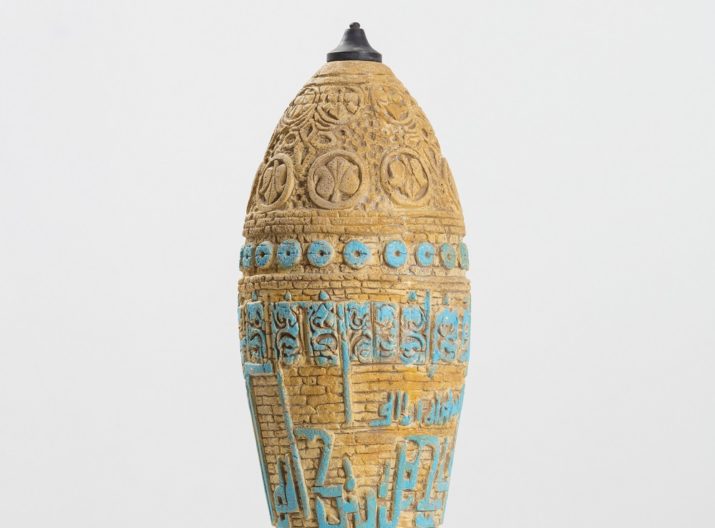
This is part of our special feature, United in Diversity.
Born in 1960, Katya A. Traboulsi is a Beirut-based multimedia artist whose practice is characterized by the emotional intensity with which she confronts the effects of the Lebanese civil war. Both her painting and sculptural works are characterized by her bold use of color, which disrupts the viewer’s expectations of the dark subject matter they are confronted with. Her solo exhibition Perpetual Identities (2018) held at the Saleh Barakat Gallery saw presented 46 hand-crafted replicas of Lebanese war bomb shells adorned with colorful patterns, beads and sculpted forms, thus transforming these destructive military objects into beautiful, ornate vessels.
In 2013, Traboulsi published “Generation War,” a body of work that traces the story of photojournalists who witnessed the civil war during the 80s – an homage to their efforts and a political project that seeks to record the country’s complex histories. Traboulsi lived and worked in Dubaï from 1989 till 2016 before returning to her native Beirut. Her work has been exhibited internationally since 1986 in Paris, London, Dubai, Kuwait, North America, the Algerian museum of Modern Art and the International Armory Show in NYC.






1975 Lebanon is in flames and I am fifteen. For my birthday, I receive the empty sleeve of a mortar shell, which I automatically place on a shelf, without any further reflection on its nature, or the circumstances that have led it to me. Thus, this object, which could have blindly brought death to the place where it fell, ended up in my room. It became a trophy, celebrating the courage of a fighter, or the defeat of an enemy whose identity changed as alliances and masters of war willed. In times of war, unconsciousness is a survival instinct.
2014, the Arab Springs wilt into winters. The memory of this object, trinket or trophy, calls on me. The questionings that arise from it inspire a project of installation which would allow to circumvent it, to divert it from its morbid destiny in order to put it at the service of life. Hence, Perpetual Identities was born, with all the meanings and in all the directions that have gradually been grafted onto the basic idea, enriching it with reflections and revelations, to make it a palimpsest project, carrier of a mission; a project to the glory of Humanity.
It was necessary to begin by carrying out the metamorphosis of which André Malraux so rightly speaks, and which aims at removing the primary function of this object in order to transcend it in the sphere of art, and load it with a universal and immortal message, to make it a melting-pot of threatened identities. This struggle for the survival of identities cannot find a more resounding echo than in those desolate times when minorities are persecuted, and their heritage pulverized and distributed as spoils of war.
Also endangered are the identities sacrificed on the altar of globalization, which imposes an aseptic and effective language, melting the peculiarities and the wealth of the peoples in lack of differentiation, gradually leading to the loss of the ancestral know-how and of the original language with its tools and its land. These forty-six shells, clothed in the arts and crafts of forty-six countries, become bibles of patterns, themes and skills, bearing the glory of every people and inviting them to join in the universal banquet of Humanity.
The shell becomes “Book,” an inventory of myths, of traditions of incarnated know-how, and calls for the discovery of the Other. Its morbid trajectory becomes exchange. The shell becomes “Arrow,” and instead of death, sows’ knowledge and civilization in the territory of the Other. Its scope becomes sociological, theological, philosophical.
This installation and this book are a testimony of faith in Man and his greatness. In art as anti-destiny, which triumphs over death and restores human dignity in creation. It is thus that an object of death forgotten on a dusty shelf, finds itself rehabilitated, transfigured in the sparkling whiteness of a museum, a place of beauty and life.
Published on April 5, 2019.




